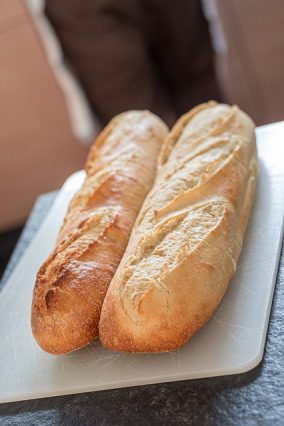———————NO INGREDIENTS AT THIS POINT———————
Making this bread, once you get set up is easy; getting set up can be
involved. The starter is an old timey creature and totally natural. To
quote Laurel’s Bread Book (and I will be apt to do that several times
because she does it so well) the desem is a living partner in the
twice-weekly adventure of its baking. This is not a project you would
try once to see how you like it, but is perfect for serious bread
eaters who can bake regularly and who want the best possible bread.
The earliest original recipe can be traced back to the Lima Bakery in
Belgium. Picked up from there by a chef (and physician) named Hy
Lerner. At this part of its journey it was found by the writers of
“The Laurel’s Kitchen’s Bread Book” and I’ll try to pass it on to you
gentle folk. Laurel’s staff reports that they feel they have
developed a perfect home-style version on the Pacific coast.
THE DESEM: The secret of the chewy-light texture, full-mellow, tangy
flavor and the extraordinary keeping quality lies within the desem.
Desem (day’-zum is Flemish for starter) Not to be confused with
sourdough. It is much more sophisticated and universal than any
rustic sourdough. They have tried many sourdough starters but none
can hold a candle to either the flavor or the leavening power of the
desem. Problems come only when the simple requirements of the desem
organisms are neglected through using flour contaminated with
pesticide residues or with mold from a dirty mill, or using
chlorinated water, or the easiest pitfall which can happen is that
the temperatures get too warm or too cold. Laurel’s staff states here
that it is their longest recipe and their simplest bread! It takes 2
weeks to get a desem starter going. The first 5 days (the starter’s
infancy) is spent in a special kind of incubator; a big bag of flour.
On the 6th day the desem is moved to the covered crock or jar. You
feed it flour and water every day this week and keep it carefully
cool.
WHAT YOU NEED TO START: Pure water. organic, stoneground wheat, and
some time in a cool cellar to bring it to vigorous life. Many of us
lead lives sufficiently hectic that to make a commitment to the
regular care of a starter dough seems like a luxury.
WATER: Pure spring water is the best, not distilled, we want the
minerals! Use this water at room temperature or cooler to feed your
desem and make up your dough. If you’re using a dough hook, your
water should be cold!
FLOUR: Coarsely gound and fresh, preferably not more than 5 days from
the milling-that’s the ideal. The flour you choose should be milled
from hard red winter wheat or hard red spring wheat. It must not have
been treated with pesticides, and it must have been milled in a clean
cool mill. Becuase of these requirements, making a desem can tell you
a lot about your flour. You’ll need at least 10 pounds of flour for
the desem’s incubator, to surround it while it is developing. Because
its freshness is so important, it is well worth the trouble to grind
this ammount yourself. You can buy wheat berries at natural food
store. If you use a grain mill, be sure that it is absolutely clean.
They speak here of a lady who found her flegeling desem growing a
“cover crop” of green mold. If you do grind your own flour, when you
measure it tap the sides of the measuring cup to compact the flour
because it will be lighter and fluffier than bagged flour.
TEMPERATURE: Find a place that is between 50 and 65 degrees to keep
the desem. The temperature is CRITICAL to growing the right organisms
in the starter. Above 70 degrees souring organisms are favored; below
50 degrees the leavening agents hibernate.
TIME: It takes 2 weeks to develop a desem. During this period, to
help the new starter get going, you need to feed it every day with a
small portion of fresh flour and water. You can use your desem to
bake with after the first week. Even when the desem is very young,
the bread is delicious; in fact, in some ways the flavor is most
interesting at this stage.
This series (of which this is only the first one) has been gleaned
from “The Laurel’s Kitchen Bread Book, A Guide to Whole Grain Bread
Making” If you truly want to make the leap into desem, I would
strongly reccomend purchasing the book, It (the book) is incredible.
Look for additional posts.
Mary Riemerman
Yields
1 starter

